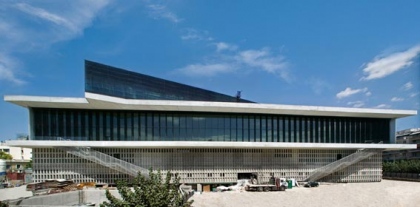
Less than 90 days are left until the official opening of the New Acropolis Museum. This was announced by its president Dimitris Pandermalis. He defined the initiative as the most significant one in Greece during the 21st century. Going back through the years, when the new museum was only an idea, its president admitted: “For me this was not just a construction of a new museum. For me this was a chance to study all layers of the Greek society, which stood in my way while I was trying to solve different problems. Also I studied the principals according to which the international diplomacy works regarding such a desired and disputed goal as the return of the marbles from the British museum.”
He reminds that the first problem, which occurred, was after the organization committee decided on the modern architecture of the museum. “Back then the public rioted. How is it possible for the Acropolis Museum to have a modern architecture! My answer was: “When you have at your disposal the prototype of the classic architecture, then it doesn’t make sense to copy it,” says Dimitris Pandermalis. The famous intellectual speaks with sadness about the disputes of whether the two buildings, which are between the museum and the Parthenon, should be brought down. “One of the biggest advantages of the New museum is the optical connection with the Parthenon. The answer to the question of whether those two buildings should be kept or not, is obvious for every objective visitor,” is convinced Mr. Pandermalis.

The problems of the new museum do not end here. One of the most spread critics against it is hwy it is so big. “The museum cannot be smaller than the Parthenon itself. Don’t forget that the exhibits inside will be more than 40 000,” explains the president of the museum. While the construction of the museum was taking place, there were 103 lawsuits files against its president. Another dispute and case was whether the museum can be build over archeological diggings. “They had to see the design of architect Bernar Shumi, who proposed a glass floor for the museum, so the visitors can see the diggings,” remembers Dimitris Pandermalis.
But even then many people were unhappy and wondering whether the archeological diggings can be shown through modern architecture. They are so different! “Of course they are different and that is the beauty of it,” answers Pandermalis. For some visitors, the archeological findings are more interesting than the Parthenon itself, because they show an unknown side of the ancient Athenians. They can see Plato’s portrait, which was found in the remains of his house, where the famous philosopher gathered his students to teach them. They can also see the remains of a building, which was about 100 years older than the Parthenon—in other words, it is a building from the classic era.
The president of the New Acropolis museum defined the return of the marbles from the British museum as the most important task of the Greek cultural diplomacy. “This is problem, which cannot be solved the way we have been trying until now. There is no point to build our argument around our national pride. There is no point to say that the marbles belong to us, because they don’t. They belong to the Parthenon,” says Dimitris Pandermalis. The New Acropolis Museum aims to convince everybody of that. The visitors see the sculptures in their real sizes. The originals, which are in Athens, have the characteristic beige-crème color. The ones, which are in the British museum, are snow white. Their combination seems surreal but it works. “From the moment when we become honest, they will take our request with bigger responsibility,” is convinced Dimitris Pandermalis.
http://www.youtube.com/watch?v=HxUEqq_ZqVs